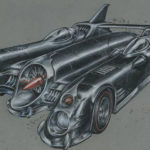‘Traditional’ LEGO SDCC exclusives fuel fan frustration
The LEGO Group’s idea that producing San Diego Comic Con exclusives is traditional doesn’t wash with LEGO fans frustrated at limited runs of near-impossible-to-acquire minifigures and sets
The latest San Diego Comic Con exclusive from the LEGO Group, BrickHeadz Marvel Spider-Man and Venom, has been announced – leading disappointed fans to voice their irritation at such exclusives on social media. The LEGO Group justified the exclusives by responding to fans online: ‘We often offer an exclusive at SDCC as is traditional for the event itself.’
To recap, LEGO event exclusives have been an annual staple since SDCC 2008 when unique releases based on Star Wars, Indiana Jones and Batman emerged. Individually carded minifigures were then introduced at SDCC in 2011 with the four DC Comics Super Heroes minifigures. Exclusives have since been produced for SDCC, New York Comic Con, Fan Expo and Star Wars Celebration for cross promotional activities that have included new theme announcements, collectible and one-off versions of generally licensed minifigures, and sometimes unusual mini-builds, which have again been one-off in nature. One of the most notable examples of an exclusive set is Action Comics #1, which recreated the iconic Superman cover in a set available at San Diego Comic Con 2015.
In practice, though, event exclusives have become a ludicrous concept as they reward random attendees rather than loyal LEGO fans who actually want the products. The people who win out in the end are those who are lucky enough to be in the right place at the right time, who then sell their super limited item on a third party selling platform and pocket a healthy sum to help pay for their hotel room.
Among the many frustrated LEGO fans are LEGO Group employees at Billund, as they can’t get these exclusives, whilst even Lucasfilm employees can’t get the LEGO Star Wars exclusives. If those well placed people can’t get them, then what chance does the average LEGO fan have?
The argument could be made that these exclusives are a treat for LEGO fans attending the event itself – but with over 130,000 attending San Diego Comic Con and some of the LEGO exclusives limited to around 1,000 pieces, there are not quite enough to go round. Rather than produce greater quantities to allow more attendees to get one of the exclusives, the LEGO Group has instead implemented a variety of lottery systems over the years.
A fascinating insight into attempting to navigate the intricacies of the LEGO booth at San Diego Comic Con is provided by FBTB, which highlights the inconsistency and unfairness that can take place. Frustrations have included the company not selling products until an hour into the show, raffle lines of hundreds of people snaking around the booth, a raffle method changing part way through the event, and rude staff operating the LEGO booth.
FBTB’s Ace is a regular at SDCC so knows how these things work but, along with other attendees in 2013, was left feeling that the LEGO employees running the exclusives raffle were rigging the process and selecting who would get an exclusive minifigure rather than allowing it to be a genuinely random giveaway. The LEGO Group clarified that the system was not gamed in anyway, but that this impression even came across in the first place demonstrates the risks inherent in these processes.
The recent Star Wars Celebration Orlando event offered a new take on the raffle – fans had to enter it in advance. That meant that a large number of the 70,000 attendees at the show turned up completely unaware that they had already missed out on a chance to get the exclusive, as they had not registered for the online raffle. Hundreds of fans queued at the LEGO booth for hours just in case those who did have a raffle ticket did not all turn up (as required at a set time) and a few sets would be left over.
The majority of fans who attend SDCC, or a similar event, do not get the chance to buy or receive the LEGO exclusive. Those who do attend then have a stressful time keeping up to date with changing rules and confusing queuing systems. Few people come away with a positive story about how they acquired these event specific sets – instead they speak of endurance and frustration. So, if all the LEGO Group is doing is alienating fans, what is the point?
We often offer an exclusive at SDCC as is traditional for the event itself.
— LEGO (@LEGO_Group) June 26, 2017
‘It is traditional’ does not really work as an answer. For starters, it is not traditional for the LEGO Group. The company has only been producing San Diego Comic Con exclusives since 2008, aside from a one-off Bionicle exclusive in 2004.
Other toy companies have been doing this for much longer than the LEGO Group, and may have a stronger argument with notions of tradition. Hasbro, for example, sells action figure exclusives at SDCC and has come in for criticism from collectors over the years, not least recently with the implementation of the multiple queuing madness. Hasbro has still received fan frustration without the super limited quantities that the LEGO Group favour, but at least more collectors do walk away happy.
In case the vague suggestion that tradition dictates the LEGO Group’s promotional efforts at SDCC was not enough, then a reply on Facebook added further insult to one fan who had decided to complain. The response was signed off with the phrase, ‘Still, we hope you’re able to get it!’ That is of course, the point – LEGO fans who are loyal collectors, spending obscene amounts of money year in, year out, cannot get these sets.
No matter how many lottery systems are implemented, the only way to allow every fan at SDCC who wants an exclusive to get one is to make more. The LEGO Group attend this event every year, it would not be hard to gauge demand. Even better, abandon this ludicrous exclusive program altogether – that should be the LEGO tradition. A few scalpers may be pleased to help fund their expensive trip to San Diego thanks to these exclusives, but a much greater number of LEGO fans feel irritated because they can’t participate.
But then if the desired effect isn’t really about the fans, but about getting coverage with websites such as Entertainment Weekly, the Hollywood Reporter and Yahoo, then perhaps these exclusives serve their purpose. But ‘traditional’? It’s time for a new tradition.











